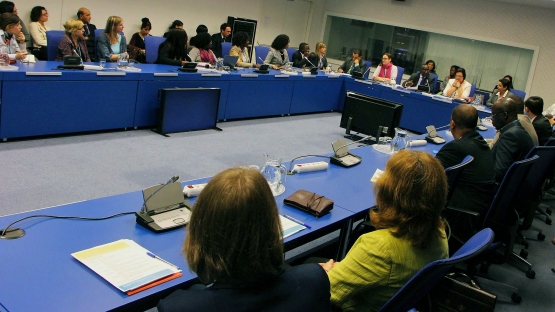Over 40 per cent of deaths of children under five years of age can be linked to malnutrition, according to 2014 data from the World Health Organization. Poor nutrition can also affect a child's brain development, which leads to reduced productivity and lowers the chances of the child escaping poverty later in life. The impact of children suffering from stunted growth and underdevelopment due to malnutrition can contribute to social and economic losses for countries worldwide, particularly for developing countries. The human and economic costs of poor nutrition can be staggering at national, regional and international levels.
The IAEA partners with its Member States and other organizations to collaboratively fight malnutrition in children. These partnerships may take many forms through agreements and working relationships between the IAEA and various Member States and international, civil society and research organizations, but one of the main aims is to strengthen the capacities of Member States to address nutrition issues and also help to bring science-based evidence to policy makers, which has an important influence on nutrition programmes. These improved capacities also facilitate a Member State's ability to further collaborate and partner with other countries and organizations on these issues to further the impact of the work done in these topics.
Partnerships are an essential aspect of addressing malnutrition, and in an effort to further enhance the visibility of these linkages with countries and organizations, a side event was held on 25 September 2014 on the margins of the IAEA 58th Annual General Conference. The side event focused on how collaboration through partnerships has successful proven results.
"Many people don't know that that IAEA uses science to improve nutrition in mothers and children, but the word is getting out and we have a lot to offer," said IAEA Deputy Director General and Head of the Department of Technical Cooperation, Kwaku Aning. "By joining hands with key nutrition development players, we can ensure that nuclear science and technology can be used to support the achievement of lasting solutions for the betterment of society."
Echoing these sentiments, Juliawati Untoro, a Nutrition Specialist from UNICEF, described nutrition as a smart investment with multiple benefits. Ms. Untoro explained that malnutrition and stunting are multi-sectorial problems, which means that effectively tackling these topics requires addressing a range of areas, from food to care and health to policy and advocacy, as well as identifying which tools, including nuclear techniques, are effective for evaluating interventions in these areas.
She said, "Partnerships can achieve what no single partner or sector can do" by drawing on the different capabilities of diverse organizations and bodies to collaboratively tackle these challenges.
Strengthening Capacities, Building Partnerships
Thailand. For decades, Thailand experienced nutrition challenges in children and mothers, from malnutrition to obesity issues. With assistance from the IAEA, including the provision of training and new equipment, Thailand built its abilities to address the country's nutrition challenges. The country started using tools like isotope techniques for projects targeting health topics related to areas such as breastfeeding, micronutrients and body composition. Projects like these not only benefited Thailand, but the country's enhanced capabilities have since allowed Thailand to collaborate with and support the work of other countries and organizations in the region and around the world.
The knowledge Thailand has gained through IAEA projects also provided the country with the leverage needed to effectively collaborate with other institutions and organizations regionally and worldwide, explained Pattanee Winichagoon from the Institute of Nutrition, Mahidol University in Thailand.
She said that "the IAEA's support helps us in strengthening our collaboration with internationally renowned scientist and laboratories," which not only provides mutual benefits, but also benefits neighbouring countries and regions. "Thailand hopes to continue building future partnerships within the region as well as internationally," Ms. Winichagoon added.
Burkina Faso. Malnutrition in children and malaria are two major challenges for Burkina Faso. Through an IAEA project designed to simultaneously address both issues, the country has experienced success in tackling these problems areas. The improved capacities have strengthened the role of Burkina Faso in addressing these issues in the region.
The IAEA "brought us [the Institute in Burkina Faso] from level zero to a level where we have a voice," said Augustin Zeba from the Institut de Recherche en Sciences de la Santé (IRSS) at the Délégation régionale de l'Ouest-Bobo-Dioulasso.
The IRSS has experienced a significant transformation in the last ten years, reflecting Burkina Faso's strengthened capabilities; the institute grew from two scientists working in an old building to a staff of more than 200 employees, including Master's degree and PhD holders, working in a newly renovated building with well-equipped laboratories that also serve as a training centre for African fellows from other countries.
These improvements have "allowed us to cross borders and work with other partners in the research field," said Mr. Zeba. "We can now look to IRSS as becoming an IAEA collaborating centre in the nutrition field in French-speaking Africa."
A Lasting Impact
"Achieving development goals and addressing the life-long issue of nutrition requires joining hands with our partners," said Ana Raffo-Caiado, Director of the IAEA Department of Technical Cooperation, Division of Support and Coordination. "We need to make strong linkages with partners, international organizations and non-governmental organizations so the positive impacts of this work remain long lasting."
Capturing the tone of the meeting, Ms. Raffo-Caiado addressed the closing question and answer session with this statement: "Partnerships are a highly fruitful element in the implementation of a project. Partnership impact doesn't stop there, however. The power of partnerships after a project closes is tremendous. We cannot see the immediate impact as it is a process that takes several years. Without strong partnerships, we cannot evaluate the impact over the long term. We hope these examples of partnerships encourage others to partner and to continue to expand the impact."


